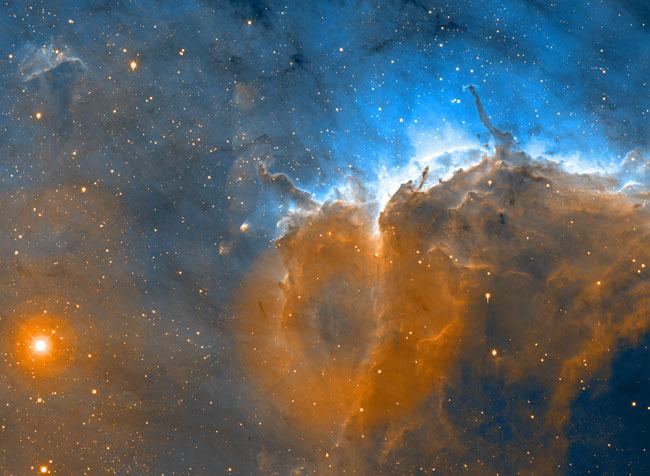Explanation: What's happening to the Pelican Nebula? The light from young energetic stars is slowly transforming the Pelican's cold gas to hot gas, with the advancing boundary between the two known as an ionization front. Most of these bright stars lie off the top of the image, but part of the bright ionization front crosses on the upper right. Particularly dense and intricate filaments of cold gas are visible along the front. Millions of years from now this nebula might no longer be known as the Pelican, as the balance and placement of stars and gas will leave something that appears completely different. The above image was taken with the Mayall 4-meter telescope at Kitt Peak National Observatory in Arizona, USA. The large circular artifact below the image center is not real. The nebula, also known as IC 5070, spans about 30 light years and lies about 1800 light years away toward the constellation of Cygnus.
1999 2000 2001 2002 2003 2004 2005 2006 2007 2008 2009 2010 2011 2012 2013 2014 2015 2016 2017 2018 2019 2020 2021 2022 2023 2024 2025 |
Yanvar' Fevral' Mart Aprel' Mai Iyun' Iyul' Avgust Sentyabr' Oktyabr' Noyabr' Dekabr' |
NASA Web Site Statements, Warnings, and Disclaimers
NASA Official: Jay Norris. Specific rights apply.
A service of: LHEA at NASA / GSFC
& Michigan Tech. U.
|
Publikacii s klyuchevymi slovami:
Pelican Nebula - ionization front - IC 5070 - Tumannost' Pelikan - ionizacionnyi front
Publikacii so slovami: Pelican Nebula - ionization front - IC 5070 - Tumannost' Pelikan - ionizacionnyi front | |
Sm. takzhe:
Vse publikacii na tu zhe temu >> | |
